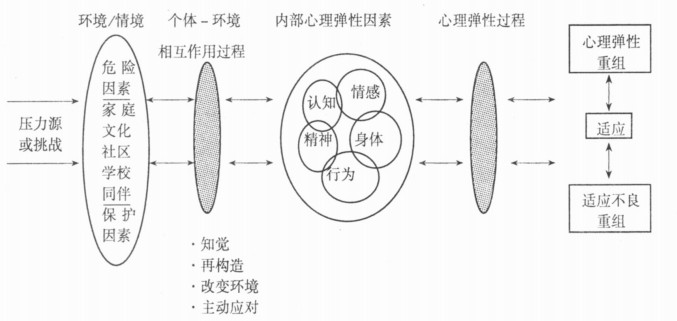-
摘要: 心理弹性目前已成为心理学的一个重要研究领域, 并日益为心理学界所关注。已有研究分别从不同角度给予心理弹性不同的定义, 虽没有形成统一的概念, 但在进行研究时, 都认可两个基本的操作性定义要素:个体遭遇逆境和个体成功应对。有关心理弹性的研究目前大多停留在第一阶段, 即对心理弹性变量的探讨; 对心理弹性内在机制的探讨是心理弹性研究的第二阶段, 这将成为今后研究的重点。本研究在综合国外大量文献的基础上重点探讨了心理弹性作用机制的理论模型, 并提出注重生态学原则、进行细化研究、拓展纵向研究、加强认知研究和实施干预研究, 将可能成为心理弹性作用机制的研究趋势。1) Waller Margaret A.Resilience in Ecosystemic Context:Evolution of the Concept.American Journal of Orthopsychiatry, 2001, 71 (3) :290-2982) Higgins, G.O.Resilient adults:Overcoming a cruel past.San Francisco:Jossey-Bass, 19943) Walsh, F..Strengtheningfamily resilience.NewYork:Guilford Press, 19984) Masten, A.S.Ordinary magic:resilence processes in development.American Psychologist, 2001, 56, 227-2385) Werner E.E.Resilience in development.American Psychological society, 19956) Lazarus R.S.Frompsychological stress tothe emotions:Ahistory of changing outlooks.Annual Reviewof Psychology, 19937) American Psychology Association Help Center:The roadtoresilience:What isresilience?http://www.apahelpcenter.org/fea-turedtopics/feature.php-id=6&ch=2, 20028) Luthar S.S, ciicchetti D., Becher B.The construct of resilience:a critical evalution and guidelinesfor future work[J].Child Development, 2000, 71, 543-5629) Kathleen T, Janyce D.Resilence:Ahistorical reviewof the construct.Holistic Nursing Practice, 200410) 曾守锤、李其维:《儿童心理弹性发展的研究综述》, 《心理科学》2003年第6期。11) Masten, A.S. & Coatsworth, J D..the development of competence infavorable and unfavorable environments:Lessons fromre-search on successful children.American Psychologist, 1998, 53, (205—220)12) 曾守锤、李其维:《儿童心理弹性发展的研究综述》, 《心理科学》2003年第6期。13) Garmezy, N.Stress-resistant children:The searchfor protective factors.InJ.Stevens (Ed.), Recent researchin developmental psychopathology[C].Oxford, England:Pergamon Press, 1985:213-23314) Kaplan, HB.Toward an Understanding of Resilience:Acritical Reviewof Definitions and Models.In Glantz, & Johnson Kluwer (eds.).Resilience and Development:Positive Life Adaptations.New York:Academic/ PlenumPublishers, 1999:55-5615) Kumpfer, K.L.Factors and processes contributing to resilience:The resilience framework.In M.D.Glantz & J.L.Johnson (Eds.), Resiliency and development:Positive life adaptations.NewYork:Kluwer Academic, 1999: (179—224)16) Richardson, G.E.The metatheory of resilience and resiliency.Journal of Clinical Psychology, 2002, 58:307-32117) Werner, E., & Smith, R. Overcomingthe odds: High-risk children from birth to adulthood.Ithaca, New York:Cornell Universi-ty, 199218) Mandleco, B.L, & Peery, J.C.An organizational frameworkfor conceptualizing resiliencein children.Journal of Child and Ado-lescent Psychiatric Nursing, 2000, 13, 99-11119) 于肖楠、张建新:《韧性(resilience)——在压力下复原和成长的心理机制》, 《心理科学进展》, 2005年第5期。20) Ollson C A, Bond L, Burns J M, Vella-Brodrick D A, Sawyer S M.Adolescent resilience:Aconcept analysis.Journal of Adoles-cence, 2003, 26:1-11
-
表 1 心理弹性的保护性因素
来源 保护性因素 个体 良好的智力机能(如较高的口头表达能力、发散性思维)
人际吸引、社交能力、容易相处的特性;
自我效能感、自信、br高度自尊;
才干;
信念。家庭 和父母形成亲密关系并在意维护父母形象;
父母的权威教育:温暖、有结构、高期望;
社会经济条件优势;
较低的家庭压力;
有序的家庭环境;
广大的、支持性的家族网络的连接;
亲社会家庭价值观;
积极的角色模型。家庭外因素 和家庭外亲社会成人的联系br参加亲社会组织;
进行有效学习 -






 下载:
下载:

